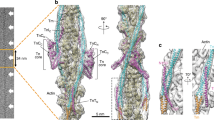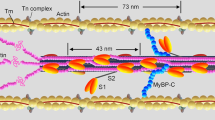Abstract
THE steric model of muscle regulation holds that tropomyosin strands running along thin filaments move away from myosin-binding sites on actin when muscle is activated. Exposing these sites would permit actomyosin interaction and contraction to proceed. This compelling and widely cited model is based on changes observed in X-ray diffraction patterns of skeletal muscle following activation1–3. Although analysis of X-ray patterns can suggest models of filament structure, unambiguous interpretation is not possible. In contrast, three-dimensional reconstruction of thin-filament electron micrographs could, in principle, offer direct confirmation of the predicted tropomyosin movement, but so far tropomyosin in skeletal muscle has been resolved definitively only in the 'on' state but not in the 'off' state4. Thin filaments from the arthropod Limulus have a similar composition to those from vertebrate skeletal muscle5, and troponin–tropomyosin is distributed in both species with the same characteristic 38-nm periodicity6. Limulus thin filaments activate skeletal muscle myosin ATPase at micro-molar Ca2+ concentrations and confer a high calcium dependence on the enzyme. Arthropod and vertebrate troponin subunits form functional hybrids in vitro7 and the respective tropomyosins are functionally interchangeable8,9, arguing for a common mechanism of thin-filament-linked regulation in the two phyla. Here we report that tropomyosin is readily resolved in native filaments of troponin-regulated Limulus muscle in both the 'on' and 'off' states, and demonstrate tropomyosin movement, providing support for the importance of steric effects in muscle activation.
This is a preview of subscription content, access via your institution
Access options
Subscribe to this journal
Receive 51 print issues and online access
$199.00 per year
only $3.90 per issue
Buy this article
- Purchase on Springer Link
- Instant access to full article PDF
Prices may be subject to local taxes which are calculated during checkout
Similar content being viewed by others
References
Huxley, H. E. Cold Spring Harbor Symp. quant Biol. 37, 361–376 (1972).
Haselgrove, J. C. Cold Spring Harbor Symp. quant. Biol. 37, 225–234 (1972).
Parry, D. A. D. & Squire, J. M. J. molec. Biol. 75, 33–55 (1973).
Milligan, R. A., Whittaker, M. & Safer, D. Nature 348, 217–221 (1990).
Lehman, W., Regenstein, J. M. & Ransom, A. L. Biochim. biophys. Acta 434, 215–222 (1976).
Lehman, W. J. molec. Biol. 154, 385–391 (1982).
Lehman, W. Nature 255, 424–426 (1975).
Lehman, W. & Szent-Györgyi, A. G. J. gen. Physiol. 59, 375–387 (1975).
Regenstein, J. M. & Szent-Györgyi, A. G. Biochemistry 14, 917–925 (1975).
Bullard, B. et al. J. molec. Biol. 204, 621–637 (1988).
Vibert, P., Craig, R. & Lehman, W. J. Cell Biol. 123, 313–321 (1993).
Cohen, C. et al. Cold Spring Harbor Symp. quant. Biol. 37, 287–297 (1972).
Flicker, P. F., Phillips, G. N. & Cohen, C. J. molec. Biol. 162, 495–501 (1982).
Holmes, K. C. & Kabsch, W. Curr. Opin. Struct. Biol. 1, 270–280 (1991).
Squire, J. M., Al-Khayat, H. A. & Yagi, N. J. chem. Soc. Farad. Trans. 89, 2717–2726 (1993).
Seymour, J. & O'Brien, E. J. Nature 283, 680–682 (1980).
Toyoshima, C. & Wakabayashi, T. J. Biochem. (Tokyo) 97, 245–263 (1985).
O'Brien, E. J., Couch, J., Johnson, G. R. P. & Morris, E. P. in Actin: Structure and Function in Muscle and Non-Muscle Cells (eds dosRemedios, C. G. & Barden, J. A.) 3–15 (Academic, North Ryde, NSW, Australia, 1983).
Rayment, I. et al. Science 261, 58–65 (1993).
Chalovich, J. M., Chock, P. B. & Eisenberg, E. J. biol. Chem. 256, 575–587 (1981).
Moody, C., Lehman, W. & Craig, R. J. Muscle Res. Cell Motil. 11, 176–185 (1990).
DeRosier, D. J. & Moore, P. B. J. molec. Biol. 52, 355–369 (1970).
Amos, L. A. & Klug, A. J. molec. Biol. 99, 51–73 (1975).
Trachtenberg, S. & DeRosier, D. J. J. molec. Biol. 195, 581–601 (1987).
Milligan, R. A. & Flicker, P. F. J. Cell Biol. 105, 29–39 (1987).
Author information
Authors and Affiliations
Rights and permissions
About this article
Cite this article
Lehman, W., Craig, R. & Vibert, P. Ca2+-induced tropomyosin movement in Limulus thin filaments revealed by three-dimensional reconstruction. Nature 368, 65–67 (1994). https://doi.org/10.1038/368065a0
Received:
Accepted:
Issue Date:
DOI: https://doi.org/10.1038/368065a0
This article is cited by
-
50 Years of the steric-blocking mechanism in vertebrate skeletal muscle: a retrospective
Journal of Muscle Research and Cell Motility (2023)
-
Caldesmon controls stress fiber force-balance through dynamic cross-linking of myosin II and actin-tropomyosin filaments
Nature Communications (2022)
-
A new twist on tropomyosin binding to actin filaments: perspectives on thin filament function, assembly and biomechanics
Journal of Muscle Research and Cell Motility (2020)
-
Thin filament dysfunctions caused by mutations in tropomyosin Tpm3.12 and Tpm1.1
Journal of Muscle Research and Cell Motility (2020)
-
The discovery of actin: “to see what everyone else has seen, and to think what nobody has thought”*
Journal of Muscle Research and Cell Motility (2020)
Comments
By submitting a comment you agree to abide by our Terms and Community Guidelines. If you find something abusive or that does not comply with our terms or guidelines please flag it as inappropriate.



